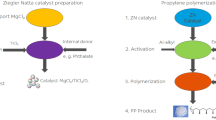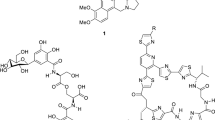Abstract
A novel helical poly(phenylisocyanide)-supported catalyst bearing (1R,2R)-1,2-cyclohexanediamine pendant (poly-2m) was synthesized. The chiral cyclohexanediamine polymer catalyst exhibited superior catalytic activity and stereoselectivity in the Michael addition reaction. The polymer poly-2200 catalyzed the Michael addition reaction of cyclohexanone with trans-nitrosostyrene in methanol at the presence of benzoic acid with an enantiomeric excess (ee) value up to 97% and diastereoselectivity (dr) value of 79/21. In addition, the chiral polymer catalyst can be recycled for 3 times in the asymmetric Michael addition reaction without significantly lossing the catalytic activity of the catalyst. Moreover, the chiral cyclohexanediamine catalyst poly-2200 can also catalyze the Aldol reaction of p-nitrobenzaldehyde with cyclohexanone, with ee value of 49% and dr value of 60/40.
Graphical Abstract
Asymmetric Michael addition reaction and Aldol reaction catalyzed by poly-2m





Similar content being viewed by others
References
Zhou XJ, Zhao JQ, Lai YQ, You Y, Wang ZH, Yuan WC (2022) Organocatalyzed asymmetric dearomative 1,3-dipolar cycloaddition of 2-nitrobenzofurans and N-2,2,2-trifluoroethylisatin ketimines. Chirality 34:1019–1034
Liu Q, Wang Y, Xie L, Cong Y, Zeng Y, Sun M, Shen Q (2023) Synthesis, characterization and anticancer activity of cis-oxalatedimycophenolic acid-(trans-1,2-cyclohexanediamine) platinum (IV). Chin J Syn Chem 31:61–66
James T, Van Gemmeren M, List B (2015) Development and applications of disulfonimides in enantioselective organocatalysis. Chem Rev 115:9388–9409
Govender T, Arvidsson PI, Maguire GEM, Kruger HG, Naicker T (2016) Enantioselective organocatalyzed transformations of β-ketoesters. Chem Rev 116:9375–9437
Qin Y, Zhu L, Luo S (2017) Organocatalysis in inert C-H bond functionalization. Chem Rev 117:9433–9520
MacMillan DWC (2008) The advent and development of organocatalysis. Nature 455:304–308
Wang YB, Tan B (2018) Construction of axially chiral compounds via asymmetric organocatalysis. Acc Chem Res 51:534–547
Shen L, Xu L, Hou XH, Liu N, Wu ZQ (2018) Polymerization amplified stereoselectivity (pass) of asymmetric Michael addition reaction and Aldol reaction catalyzed by helical poly(phenyl isocyanide) bearing secondary amine pendants. Macromolecules 51(23):9547–9554
Evans AC, Lu A, Ondeck C, Longbottom DA, O’Reilly RK (2010) Organocatalytic tunable amino acid polymers prepared by controlled radical polymerization. Macromolecules 43:6374–6380
Nagata Y, Nishikawa T, Suginome M (2015) Exerting control over the helical chirality in the main chain of sergeants- and -soldiers-type poly(quinoxaline-2,3-diyl)s by changing from random to block copolymerization protocols. J Am Chem Soc 137:4070–4073
Maeda K, Yashima E (2017) Helical polyacetylenes induced via noncovalent chiral interactions and their applications as chiral materials. Top Curr Chem 375(4):72
Fujiki M (2014) Supramolecular chirality: solvent chirality transfer in molecular chemistry and polymer chemistry. Symmetry 6(3):677–703
Yashima E, Maeda K (2008) Chirality-responsive helical polymers. Macromolecules 41(1):3–12
Zhou L, Chu BF, Xu XY, Xu L, Liu N, Wu ZQ (2017) Significant improvement on enantioselectivity and diastereoselectivity of organocatalyzed asymmetric Aldol reaction using helical polyisocyanides bearing proline pendants. ACS Macro Lett 6(8):824–829
Gao H, Liu Z, Li CL (2022) Preparation and performance of cyclohexanediamine supported catalyst. Chem Reag 44:1519–1524
Zhang C, Qiu Y, Bo S, Wang F, Wang Y, Liu L, Zhou Y, Niu H, Dong H, Satoh T (2019) Recyclable helical poly(phenylacetylene)-supported catalyst for asymmetric Aldol reaction in aqueous media. J Polym Sci Part A 57:1024–1031
Li CL, Wang JH, Ding HY (2021) Recyclable helical poly(phenyl isocyanide)-supported L-proline catalyst for direct asymmetric Aldol reaction in brine. Catal Lett 151:1180–1190
Deng JR, Zhao B, Deng JP (2016) Optically active helical polyacetylene bearing ferrocenyl amino-acid derivative in pendants. Preparation and application as chiral organocatalyst for asymmetric Aldol reaction. Ind Eng Chem Res 55:7328–7337
Wu ZQ, Song X, Li YX, Zhou L, Zhu YY, Chen Z, Liu N (2023) Achiral organoiodine-functionalized helical polyisocyanides for multiple asymmetric dearomative oxidations. Nat Commun 14:566
Xue YX, Zhu YY, Gao LM, He XY, Liu N, Zhang WY, Yin J, Ding YS, Zhou HP, Wu ZQ (2014) Air-stable (phenylbuta-1,3-diynyl)palladium(II) complexes: highly active initiators for living polymerization of isocyanides. J Am Chem Soc 136(12):4706–4713
Hu G, Li W, Hu Y, Xu A, Yan J, Liu L, Zhang X, Liu K, Zhang AF (2013) Water-soluble chiral polyisocyanides showing thermoresponsive behavior. Macromolecules 46:1124–1132
Asaoka S, Joza A, Minagawa S, Song LJ, Suzuki Y, Iyoda T (2013) Fast controlled living polymerization of arylisocyanide initiated by aromatic nucleophile adduct of nickel isocyanide complex. ACS Macro Lett 2:906–911
Zhao QQ, Lam YH, Kheirabadi M, Xu CS, Houk KN, Schafmeister CE (2012) Hydrophobic substituent effects on Proline catalysis of Aldol reactions in water. J Org Chem 77(10):4784–4792
Serra-Pont A, Alfonso I, Jimeno C, Solà J (2015) Dynamic assembly of a zinc-templated bifunctional organocatalyst in the presence of water for the asymmetric Aldol reaction. Chem Commun 51:17386–17389
Obregon-Zúniga A, Milan M, Juaristi E (2017) Improving the catalytic performance of (S)-Proline as organocatalyst in asymmetric Aldol reactions in the presence of solvate ionic liquids: involvement of a supramolecular aggregate. Org Lett 19(5):1108–1111
Tan B, Zeng XF, Lu YP, Chua P, Zhong GF (2009) Rational design of organocatalyst: highly stereoselective Michael addition of cyclic ketones to nitroolefins. Org Lett 11:1927–1930
Delaney JP, Brozinski HL, Henderson LC (2013) Synergistic effects within a C 2-symmetric organocatalyst: the potential formation of a chiral catalytic pocket. Org Biomol Chem 11:2951–2960
Kim J, Kim DO, Kim DW, Sagong K (2013) Synthesis of MOF having hydroxyl functional side groups and optimization of activation process for the maximization of its BET surface area. J Solid State Chem 197:261–265
Funding
This work was supported by the Natural Science Foundation of Ningxia Province (Grant Number 2022AAC03249), the National Natural Science Foundation of China (NSFC, Nos. 52263022), the Graduate Student Innovation Project of North Minzu University (Grant Number YCX22161), the Scientific Research Start-up Project for Recruitment Talents of North Minzu University in 2020 (Grant Number 2020KYQD11). The author would like to Prof. Zong-Quan Wu of the College of Chemistry at Jilin University for his guidance during my three years of study.
Author information
Authors and Affiliations
Corresponding author
Ethics declarations
Conflict of interest
The authors declare no competing financial interest.
Additional information
Publisher's Note
Springer Nature remains neutral with regard to jurisdictional claims in published maps and institutional affiliations.
Supplementary Information
Below is the link to the electronic supplementary material.
Rights and permissions
Springer Nature or its licensor (e.g. a society or other partner) holds exclusive rights to this article under a publishing agreement with the author(s) or other rightsholder(s); author self-archiving of the accepted manuscript version of this article is solely governed by the terms of such publishing agreement and applicable law.
About this article
Cite this article
Li, C., Zhan, M., Wang, Z. et al. Novel Chiral Helical Polyisocyanides Containing Cyclohexanediamine Pendants for Asymmetric Michael Addition Reaction and Aldol Reaction. Catal Lett 154, 1420–1430 (2024). https://doi.org/10.1007/s10562-023-04423-x
Received:
Accepted:
Published:
Issue Date:
DOI: https://doi.org/10.1007/s10562-023-04423-x




